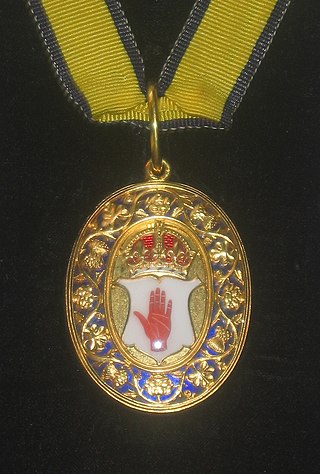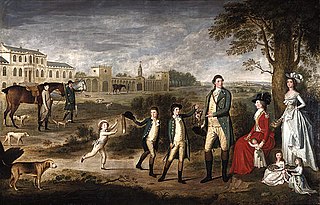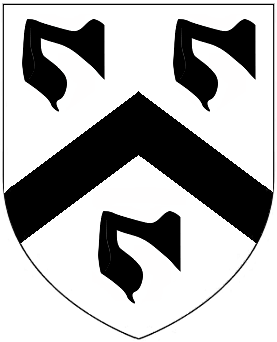Related Research Articles

A baronet or the female equivalent, a baronetess, is the holder of a baronetcy, a hereditary title awarded by the British Crown. The title of baronet is mentioned as early as the 14th century, however, in its current usage it was created by James I of England in 1611 as a means of raising funds for the crown.

There have been three baronetcies created for members of the Bacon family, all in the Baronetage of England. As of 2008, one creation is extinct and two of the creations are extant. The extant titles have been merged since 1755.
There have been 18 baronetcies created for persons with the surname Campbell, six in the Baronetage of Nova Scotia and twelve in the Baronetage of the United Kingdom.
There have been six Baronetcies created for persons with the surname Brown, one in the Baronetage of Nova Scotia, one in the Baronetage of England, two in the Baronetage of Great Britain and two in the Baronetage of the United Kingdom. Two creations are extant as of 2010.

There have been five baronetcies of the United Kingdom created for a person with the surname Erskine, two in the Baronetage of Nova Scotia, one in the Baronetage of Great Britain and two in the Baronetage of the United Kingdom. Two of the creations are extant as of 2010.
There have been five Baronetcies created for people with the surname Forbes, four in the Baronetage of Nova Scotia and one in the Baronetage of the United Kingdom. The first holder of the Burn Baronetcy of Jessfield, created in the Baronetage of the United Kingdom in 1923, assumed the surname of Forbes-Leith of Fyvie in 1925.

There have been three baronetcies created for persons with the surname Chichester, one in the Baronetage of England and two in the Baronetage of the United Kingdom. Only the 1641 creation is extant.
There have been four baronetcies created for persons with the surname Preston, two in the Baronetage of Nova Scotia, one in the Baronetage of England and another in the Baronetage of the United Kingdom.
There have been three baronetcies created for persons with the surname Noel, two in the Baronetage of England and one in the Baronetage of Great Britain. One creation is extant as of 2008.

There have been three baronetcies created for persons with the surname Style, one in the Baronetage of Ireland and two in the Baronetage of England. Two of the creations were in favour of the same person. As of 2014 one creation is extant.
There have been four baronetcies created for members of the Thorold family of Lincolnshire, two in the Baronetage of England and two in the Baronetage of Great Britain. As of 2014 one creation is extant.

There have been three baronetcies, all in the Baronetage of England, created for members of the family of Mansel, which played a major role in the early re-settlement of the Gower Peninsula, in Glamorgan, Wales. Only one creation is extant as of 2008.

The Mostyn baronets are two lines of Welsh baronets holding baronetcies created in 1660 and 1670, both in the Baronetage of England. One creation is extant as of 2015. The two lines are related and both claim descent from Edwin of Tegeingl, an 11th-century lord of Tegeingl, a territory which approximates modern Flintshire.

There have been four baronetcies created for members of the ancient House of Beaumont, all in the Baronetage of England. All four creations are extinct or dormant.
There have been five baronetcies created for members of Clan Ramsay, four in the Baronetage of Nova Scotia and one in the Baronetage of the United Kingdom. The baronetcy in the Baronetage of the United Kingdom is extant as of 2023.

There have been six baronetcies created for members of the Corbet family, four in the Baronetage of England, one in the Baronetage of Great Britain and one in the Baronetage of the United Kingdom. All creations are extinct. The recipients were descendants of the ancient Norman family of Corbet which held substantial estates in Shropshire including Wattlesborough, Caus Castle, Moreton Corbet Castle and Acton Reynald Hall.

There has been six baronetcies created for persons with the surname Shaw, one in the Baronetage of England, one in the Baronetage of Nova Scotia and four in the Baronetage of the United Kingdom. Two of the creations extant as of 2010.
Sir George Stonhouse, 3rd Baronet was an English politician who sat in the House of Commons from 1640 to 1644 and from 1660 to 1675. He supported the Royalists during the English Civil War.
Sir John Stonhouse, 2nd Baronet (1639–1700) was an English politician who sat in the House of Commons at various times between 1675 and 1690.

Sir John Stonhouse, 3rd Baronet, PC (c.1672–1733) was an English landowner and Tory politician who sat in the English and then British House of Commons from 1701 to 1733.
References
- ↑ Cokayne, George Edward, ed. (1902), Complete Baronetage volume 2 (1625-1649), vol. 2, Exeter: William Pollard and Co, p. 36, retrieved 10 June 2019
- ↑ Cokayne, George Edward, ed. (1904), Complete Baronetage volume 4 (1665-1707), vol. 4, Exeter: William Pollard and Co, retrieved 10 June 2019
- ↑ Cokayne, George Edward, ed. (1902), Complete Baronetage volume 2 (1625-1649), vol. 2, Exeter: William Pollard and Co, p. 89, retrieved 10 June 2019
- ↑ Morris, Susan; Bosberry-Scott, Wendy; Belfield, Gervase, eds. (2019). "Stonhouse: First Creation (E); 1628; Second Creation (E); 1670, of Radley, Berkshire". Debrett's Peerage and Baronetage. Vol. 2 (150th ed.). London: Debrett's Ltd. pp. 5616–5617. ISBN 978-1-999767-0-5-1.
- Kidd, Charles, Williamson, David (editors). Debrett's Peerage and Baronetage (1990 edition). New York: St Martin's Press, 1990.